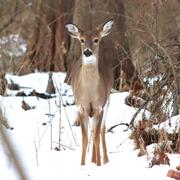Environmental Contaminants
Environmental Contaminants
Filter Total Items: 12
Key Values of a Century of EESC Science
The USGS Eastern Ecological Science Center (EESC) is rooted in a proud tradition of service to the nation—advancing science that informs the conservation and management of fish, wildlife, and habitats across the eastern United States and beyond. Our mission is clear: deliver reliable, partner-driven science that supports natural resource decisions today, while ensuring these resources remain...
EESC Makes an Impact: Preserving our Hunting Resources
Hunting is an economic engine for the U.S. and responsible management of these resources directly supports 45.2 billion dollars spent by hunters annually. Conservation and management of hunting resources also contributes substantially to the 394.8 billion dollars spent on all wildlife-related recreation. Hunting traditions are an integral component of our American heritage, with 14.4 million...
Fish and Aquatic Animal Health Publications, 2021 – 2022
Below are journal articles about fish and aquatic animal health from the Eastern Ecological Science Center published in 2021 and 2022.
Immune System Changes and Susceptibility to Disease in Birds Exposed to Environmental Contaminants
Disease dynamics in wildlife are commonly related to changes or increases in environmental stressors that are placed upon an animal. Environmental pollutants are known to affect the immune system of wildlife, resulting in impaired resistance to infection and potential increases in disease outbreaks. In collaboration with: Jill Jenkins, Ph.D USGS Wetland and Aquatic Research Center; Julia Lankton...
Effects of Short Chain Chlorinated Paraffins (SCCPs) on developing birds
The Challenge: Short-Chain Chlorinated Paraffins (SCCPs) are complex technical mixtures of polychlorinated n-alkanes used in lubricants and coolants in metalworking, as flame retardants, and in paints, adhesives, sealants, textiles and polymeric materials, plastics and rubber. SCCPs are of concern because they are globally transported, bioaccumulate in wildlife and humans, and are environmentally...
Do pesticide coatings on agricultural seeds pose a threat to earthworms and to the birds that eat them?
Earthworms are a vital part of a healthy, functioning soil ecosystem and are also an important protein-rich food source for wildlife, including many species of birds and mammals. In an agricultural setting, the presence of earthworms can increase crop yields by 25%, but can also expose earthworms to pesticides. Seed treatment is the principal application method for neonicotinoid insecticides, one...
Terrestrial wildlife and legacy oil mining on National Wildlife Refuges
Amphibian surveys are being conducted on select National Wildlife Refuges with active and/or legacy oil mining to determine species relative distribution and their risk to short- and long-term effects from exposure to crude oil and its byproducts.
Produced water from Marcellus Shale and amphibians
Research biologists at the USGS Eastern Ecological Science Center (EESC) at the Patuxent Research Refuge are conducting a series of scientific studies on the potential effects of wastewater from hydraulic fracturing activities on terrestrial wildlife. Findings will help in assessing proposals for managing recycling and distribution of large volumes of flowback and produced waters generated by...
Dysbiosis, immunomodulation, and health effects of agricultural pesticides in wild prairie grouse
Agrochemical pollution poses a severe threat to biodiversity. Agrochemicals can detrimentally affect wildlife growth, development, survival, reproduction, and immune responses, which facilitates emergence and spread of infectious diseases that may cause unusually high mortality. Animal microbiota plays a fundamental role in host’s food detoxification and defense against pathogens, regulates...
Determining carcass scavenging rates on major rivers for oil spill response and NRDAR
We are conducting avian carcass detection and persistence trials to generate an estimator to correct for the avian injuries that are not found after a oil spill on inland rivers.
Does tropospheric ozone, resulting from fossil fuel combustion, disrupt bee pollination?
The Challenge: Pollinators such as bees use floral volatiles to guide them to flowers. Tropospheric ozone produced from fossil fuel combustion products can breakdown floral volatiles. Interference with bee pollination threatens habitat quality and biodiversity and the security of the US food supply system.
Identifying the Genetic Basis of Avian Susceptibility to Mercury
The Challenge: Mercury is a highly toxic element found throughout our environment. Although it occurs naturally in some environments, human industrial pollution has greatly increased the amount of mercury and the range of environments in which mercury is found. Recent studies have confirmed clear differences in the sensitivity of various bird species to methylmercury. Because the causes of these...













